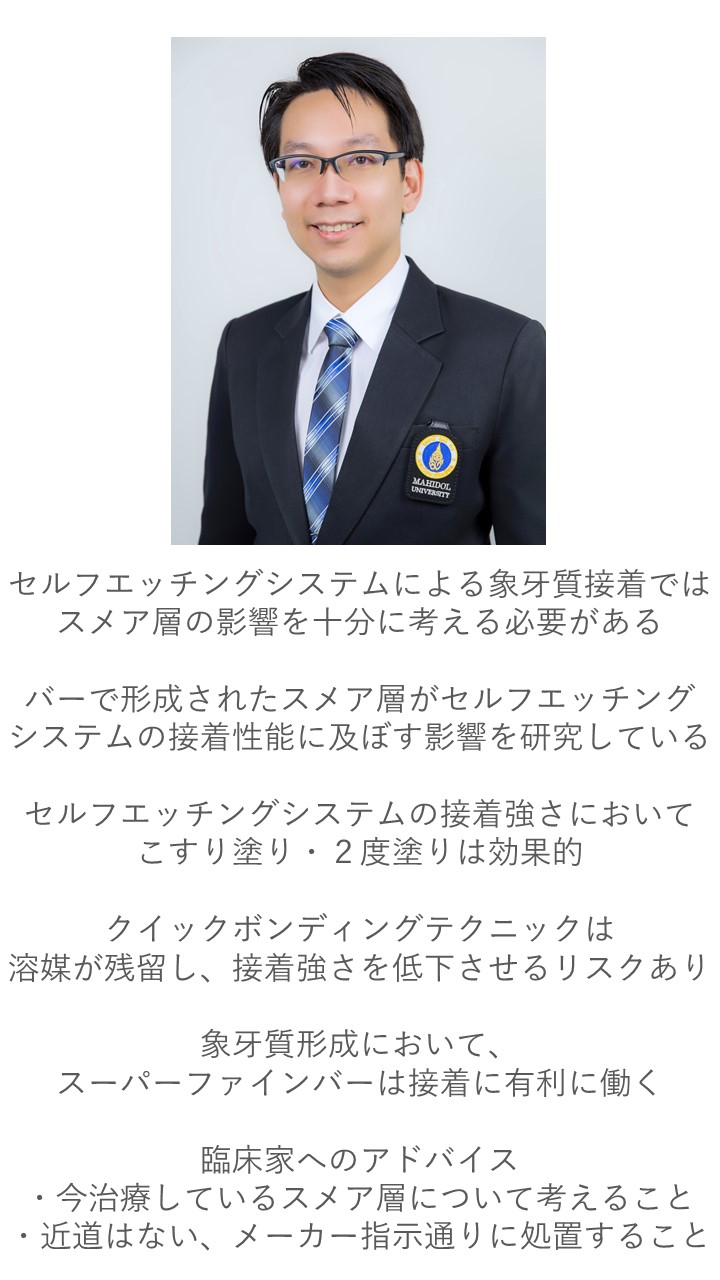
■ 経歴等
出身大学:
Doctor of Dental Surgery, Mahidol University, Bangkok, Thailand(08年卒)
Higher Grad in Operative Dentistry, Mahidol University, Bangkok, Thailand(11年卒)
Master degree in Dental Science (Operative Dentistry), Mahidol University, Bangkok, Thailand(13年卒)
出身大学院:
Ph.D. in Dental science (Operative Dentistry), Hokkaido University, Hokkaido, Japan
■ 現在の肩書:
Lecturer at Faculty of Dentistry, Mahidol University, Bangkok, Thailand
■ 研究キーワード
Smear layer, self-etching adhesive, universal adhesive, transmission electron microscope, surface preparation
■ Research outline(研究概要)
Adhesive system can be divided into 2 strategies: smear layer removal (etch-and-rinse) and smear layer modification (self-etch). Smear layer is completely removed by phosphoric acid in etch-and-rinse system. On the other hand, due to the weak acidity of the self-etching system, smear layer is partially dissolved by acidic monomer. The residual smear layer is subsequently incorporated into the hybrid layer. There was a concern that smear layer might affect the penetration of self-etching adhesive to underlying dentin, especially mild self-etching adhesives.
歯質接着は、大きく分けてリン酸エッチングシステム(象牙質表層のスメア層を完全に除去するタイプ)と、セルフエッチングシステム(酸性度が低いためスメア層を部分的に除去され樹脂含浸層となるタイプ)する2つのタイプに分かれます。
酸性度がマイルドなセルフエッチングシステム(セルフエッチングシステムの中でも製品によって酸性度は異なる)においては、レジンモノマーの象牙質への浸透(スメア層下の象牙質)にスメア層が影響を与える可能性が懸念されています。
However, previous studies demonstrated the controversial results about this issue. In addition, characteristics of smear layer may vary according to the instrument used for surface preparation and lead to the different outcome when bonded to self-etching system.
この点については議論されており、更に窩洞形成に使用する器具(バ―の種類等)により、スメア層の特性は異なる可能性があり、結果としてセルフエッチングシステムを使用した場合の接着強さに影響を与える可能性があります。
My research topics are focused mainly on the effect of smear layer created from different instruments on the bonding performance of self-etching adhesives and how to improve the bonding effectiveness when using self-etching adhesives.
私の研究テーマは、様々な器具(バーの種類等)により作られたスメア層がセルフエッチングシステムの接着性能に及ぼす影響を検証することと、セルフエッチングシステムを使用するうえでの接着性能の向上させる方法についてフォーカスを当てています。
■ Research results(研究成果)
According to the results of my previous studies, the bonding outcome of self-etching adhesives were affected by the instruments for smear layer preparation. The thickness of smear layer is also important but the density of smear layer has more impact on the resultant bond strength. Silicon carbide papers are routinely used in laboratory research to standardize the dentin surface. However, the diamond burs are more clinically relevant. It was the diamond bur-cut smear layer that demonstrated negative effect on the bond strength of self-etching adhesive. The plausible explanation might be due to the different characteristic of smear layer from different surface preparations. The higher heat and pressure created during high-speed cutting with diamond bur might lead to the more compact smear layer and therefore, more difficult for mild acidic monomer of self-etching adhesive to demineralize. The remnant of smear layer that incorporated into the hybrid layer might be the reason for the lower bond strength.
Therefore, it is important to understand the effect of different smear layer preparation when self-etching adhesive is used.
私の研究結果によると、セルフエッチングシステムの接着性能はスメア層(特にスメア層の密度)の影響をうけます。通常の接着試験では被着面を標準化するために耐水ペーパーで研磨しますが、臨床を模してダイヤモンドバーで形成された被着面にセルフエッチングシステムを使用すると接着強さは低下します。
この理由としては、高速切削中に発生する熱と圧力により、スメア層が密になり、酸性度が弱いセルフエッチングプライマーではスメア層の脱灰(スメア層内へのレジンの浸透も含め)が難しくなるからと考えております。樹脂含浸層内に残存するスメア層の残り(レジンによりモディファイされていないスメア層)が接着強度低下の原因である可能性があるため、セルフエッチングシステムを使用する場合は、形成により作られたスメア層が接着に与える影響を十分に理解することが重要です。
The second research topic is about how to improve the bond strength using self-etching adhesive. Due to mild acidity of self-etching adhesive, many bonding modifications can be done to improve the bonding performance. The mechanical application e.g. active application or double application demonstrated the beneficial effect regarding smear layer removal, resin penetration and more integrated adhesive layer. Some adhesive might be suggested by the manufacturer to apply and leave without disturb but we found that actively applied the adhesive can improve the bond strength.
2つ目の研究トピックは、セルフエッチングシステムにおける接着強さの向上についてです。ボンディング材を塗布する際に機械的刺激(こすり塗り)を与えたり、2度塗りしたりすると、接着に有益な効果をもたらします。メーカーより「ボンディング材塗布後○○秒放置」と指示されているものもいくつかありますが、ボンディング材を積極的に塗布することで接着強さが向上することがわかりました。
The recent materials were claiming that the bond strength is still high even the adhesive is applied with the reduced application time (quick bonding technique). However, we are the first group that demonstrated the drawback of such application technique. Bonding with reduced application time led to the lower bond strength and more porosity in the adhesive layer. The porosity might be the solvent entrapped in the adhesive layer that failed to evaporate due to the limited application time. By applying the adhesive according to the manufacturer’s instruction allowed more time for adhesive to demineralize smear layer and more solvent evaporation.
最近の材料では、接着材塗布時間を短縮しても接着強さは低下しないといわれています(クイックボンディングテクニック)が、我々研究グループは、この問題点を世界で初めて指摘しました。
塗布時間を短縮(塗布後すぐ接着)すると、ボンディング材に含まれる溶媒が蒸発できないため残留し、ボンディング層の多孔性が高まるため接着強さが低下します。ですから、メーカーの指示通りに接着操作を行うことで、スメア層脱灰と溶媒蒸発のための時間を確保することが重要です。
Another way to improve solvent evaporation is to extended air-blowing time. We found that extension of the air-blowing time from 5 s (as suggested by the manufacturer) to 15 s or 30 s can improve the immediate and long-term bond strength of the ethanol-based adhesive. However, the effect is material dependent. For the acetone-based adhesive, the bond strength was similar but the solvent entrapped in the adhesive layer were reduced, as observed the lower incidence of porosity in the adhesive layer from SEM observation.
溶媒の蒸発を改善するもう一つの方法として、エアブローの延長が挙げられます。エタノールベースのボンディングシステムでは、メーカー指示の5秒から15、30秒に延長すると短期・長期の接着強さが向上することがわかりました。アセトンベースでは接着強さは変わりませんが、SEM観察によりボンディング層内の気孔率の低下が観察されました。
■ Future research(展望)
As I mentioned before that the instrument for smear layer preparation is important when using self-etching adhesive, my research topic is now focusing on the effect of the current bur-cut smear layer. We regularly use coarse diamond bur for tooth preparation. However, it was reported that carbide bur also gives the good outcome. In addition, the superfine diamond bur with the smaller abrasive particle size might lead to the thinner smear layer and higher bond strength. These bur-cut smear layers combined with the simulate pulpal pressure would be interesting to see whether there is any difference.
前述の通り、セルフエッチングシステムを使用する際には、形成する器具(バー等)が重要であることをお話ししましたが、現在私はバーで形成されたスメア層の影響についてフォーカスを当てています。我々は形成する際、通常荒い(コース)ダイヤモンドバーを使用しますが、カーバイドバーでも良い結果が得られると報告があります。加えて、スーパーファインダイヤモンドバーでは、スメア層を薄くでき、接着強さを高めることができる可能性があります。
今後は、以上のようなバーにより形成されたスメア層と歯髄圧をシミュレーションして、どのような違いがあるかを研究していこうと考えております。
■ For Clinicians(臨床家の先生方にお伝えしたいこと)
For clinicians, I think that it is important to understand that what kind of smear layer that we are dealing with. Most publications tested the bonding performance of the adhesive on the SiC-ground dentin. Therefore, the outcome might be different when compared to the bur-cut dentin. One more thing is to apply the adhesive according to the manufacturers’ instruction. Most of the shortcuts lead to the wrong way or inferior outcome. It is better to do more than the instruction rather than finding shortcuts.
臨床家にとって、「今自分が扱っている被着面には、どのようなスメア層なのか」を理解していただくことが重要だと私は考えています。
ほとんどの論文・書籍等では、耐水研磨紙で研磨された象牙質への接着性能を評価しているため、臨床に則したバーカット象牙質と比較した場合、結果は異なる可能性があります。
もう一つご注意いただきたいこと。これはメーカー指示に従ってボンディング操作を行うことです。ほとんどの近道(処理の簡素化)は不幸な結果を招きます。近道を探すよりも、説明書に書かれている以上の手間をかけた方が、臨床的に良いと考えております。

